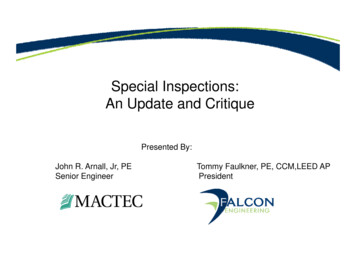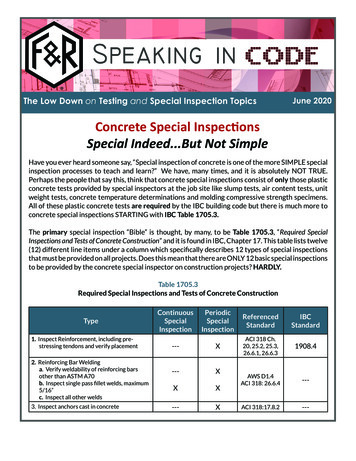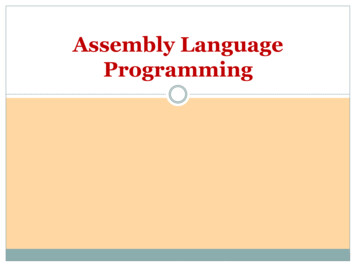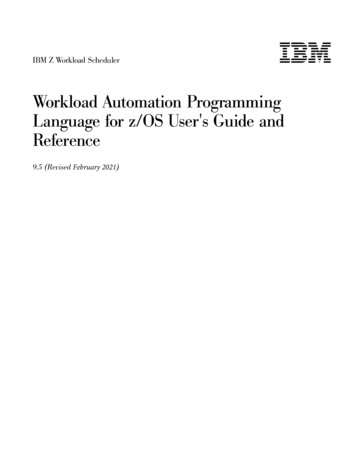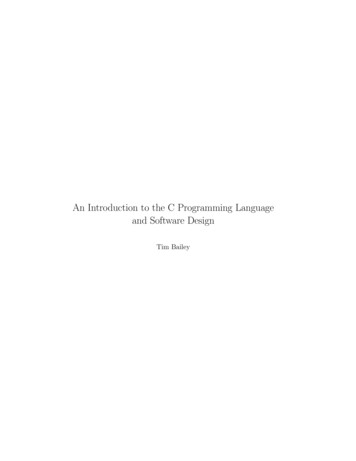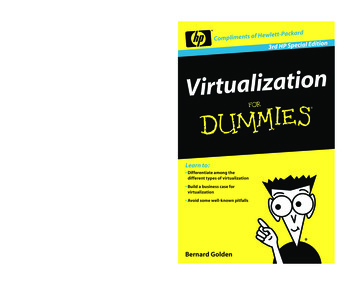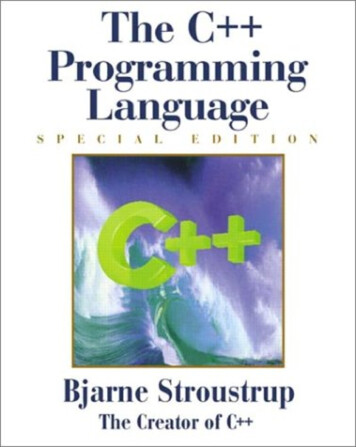
Transcription
TheC ProgrammingLanguageThird EditionBjarne StroustrupAT&T LabsMurray Hill, New JerseyAddison-WesleyAn Imprint of Addison Wesley Longman, Inc.Reading, Massachusetts Harlow, England Menlo Park, CaliforniaBerkeley, California Don Mills, Ontario SydneyBonn Amsterdam Tokyo Mexico City
iiMany of the designations used by manufacturers and sellers to distinguish their products are claimed as trademarks. Wherethose designations appear in this book, and Addison-Wesley was aware of a trademark claim, the designations have beenprinted in initial capital letters or all capital lettersThe author and publisher have taken care in the preparation of this book, but make no expressed or implied warranty of anykind and assume no responsibility for errors or omissions. No liability is assumed for incidental or consequential damages inconnection with or arising out of the use of the information contained herein.The publisher offers discounts on this book when ordered in quantity for special sales. For more information please contact:Corporate & Professional Publishing GroupAddison-Wesley Publishing CompanyOne Jacob WayReading, Massachusetts 01867Library of Congress Cataloging-in-Publication DataStroustrup, BjarneThe C Programming Language / Bjarne Stroustrup. — 3rd. ed.p.cm.Includes index.ISBN 0-201-88954-41. C (Computer Programming Language) I. IPCopyright 1997 by AT&TAll rights reserved. No part of this publication may be reproduced, stored in a retrieval system, or transmitted, in any form orby any means, electronic, mechanical, photocopying, recording, or otherwise, without the prior written permission of thepublisher. Printed in the United States of America.This book was typeset in Times and Courier by the author.ISBN 0-201-88954-4Printed on recycled paper1 2 3 4 5 6 7 8 9—CRW—0100999897First printing, June 1997
ContentsContentsiiiPrefacevPreface to Second EditionviiPreface to First EditionixIntroductory Material11 Notes to the Reader .2 A Tour of C .3 A Tour of the Standard Library .32145Part I: Basic Facilities456789Types and Declarations .Pointers, Arrays, and Structures .Expressions and Statements .Functions .Namespaces and Exceptions .Source Files and Programs .676987107143165197The C Programming Language, Third Edition by Bjarne Stroustrup. Copyright 1997 by AT&T.Published by Addison Wesley Longman, Inc. ISBN 0-201-88954-4. All rights reserved.
ivContentsPart II: Abstraction Mechanisms101112131415Classes .Operator Overloading .Derived Classes .Templates .Exception Handling .Class Hierarchies .Part III: The Standard Library16171819202122Library Organization and Containers .Standard Containers .Algorithms and Function Objects .Iterators and Allocators .Strings .Streams .Numerics .Part IV: Design Using C 23 Development and Design .24 Design and Programming .25 Roles of Classes .AppendicesA The C Grammar .B Compatibility .C Technicalities 7689691723765791793815827869The C Programming Language, Third Edition by Bjarne Stroustrup. Copyright 1997 by AT&T.Published by Addison Wesley Longman, Inc. ISBN 0-201-88954-4. All rights reserved.
PrefaceProgramming is understanding.– Kristen NygaardI find using C more enjoyable than ever. C ’s support for design and programming hasimproved dramatically over the years, and lots of new helpful techniques have been developed forits use. However, C is not just fun. Ordinary practical programmers have achieved significantimprovements in productivity, maintainability, flexibility, and quality in projects of just about anykind and scale. By now, C has fulfilled most of the hopes I originally had for it, and also succeeded at tasks I hadn’t even dreamt of.This book introduces standard C † and the key programming and design techniques supportedby C . Standard C is a far more powerful and polished language than the version of C introduced by the first edition of this book. New language features such as namespaces, exceptions,templates, and run-time type identification allow many techniques to be applied more directly thanwas possible before, and the standard library allows the programmer to start from a much higherlevel than the bare language.About a third of the information in the second edition of this book came from the first. Thisthird edition is the result of a rewrite of even larger magnitude. It offers something to even themost experienced C programmer; at the same time, this book is easier for the novice to approachthan its predecessors were. The explosion of C use and the massive amount of experience accumulated as a result makes this possible.The definition of an extensive standard library makes a difference to the way C concepts canbe presented. As before, this book presents C independently of any particular implementation,and as before, the tutorial chapters present language constructs and concepts in a ‘‘bottom up’’order so that a construct is used only after it has been defined. However, it is much easier to use awell-designed library than it is to understand the details of its implementation. Therefore, the standard library can be used to provide realistic and interesting examples well before a reader can beassumed to understand its inner workings. The standard library itself is also a fertile source of programming examples and design techniques.† ISO/IEC 14882, Standard for the C Programming Language.The C Programming Language, Third Edition by Bjarne Stroustrup. Copyright 1997 by AT&T.Published by Addison Wesley Longman, Inc. ISBN 0-201-88954-4. All rights reserved.
viPrefaceThis book presents every major C language feature and the standard library. It is organizedaround language and library facilities. However, features are presented in the context of their use.That is, the focus is on the language as the tool for design and programming rather than on the language in itself. This book demonstrates key techniques that make C effective and teaches thefundamental concepts necessary for mastery. Except where illustrating technicalities, examples aretaken from the domain of systems software. A companion, The Annotated C Language Standard, presents the complete language definition together with annotations to make it more comprehensible.The primary aim of this book is to help the reader understand how the facilities offered by C support key programming techniques. The aim is to take the reader far beyond the point where heor she gets code running primarily by copying examples and emulating programming styles fromother languages. Only a good understanding of the ideas behind the language facilities leads tomastery. Supplemented by implementation documentation, the information provided is sufficientfor completing significant real-world projects. The hope is that this book will help the reader gainnew insights and become a better programmer and designer.AcknowledgmentsIn addition to the people mentioned in the acknowledgement sections of the first and second editions, I would like to thank Matt Austern, Hans Boehm, Don Caldwell, Lawrence Crowl, AlanFeuer, Andrew Forrest, David Gay, Tim Griffin, Peter Juhl, Brian Kernighan, Andrew Koenig,Mike Mowbray, Rob Murray, Lee Nackman, Joseph Newcomer, Alex Stepanov, David Vandevoorde, Peter Weinberger, and Chris Van Wyk for commenting on draft chapters of this third edition.Without their help and suggestions, this book would have been harder to understand, containedmore errors, been slightly less complete, and probably been a little bit shorter.I would also like to thank the volunteers on the C standards committees who did an immenseamount of constructive work to make C what it is today. It is slightly unfair to single out individuals, but it would be even more unfair not to mention anyone, so I’d like to especially mention.Mike Ball, Dag Bruck, Sean Corfield, Ted Goldstein, Kim Knuttila, Andrew Koenig, Josée Lajoie,Dmitry Lenkov, Nathan Myers, Martin O’Riordan, Tom Plum, Jonathan Shopiro, John Spicer,Jerry Schwarz, Alex Stepanov, and Mike Vilot, as people who each directly cooperated with meover some part of C and its standard library.Murray Hill, New JerseyBjarne StroustrupThe C Programming Language, Third Edition by Bjarne Stroustrup. Copyright 1997 by AT&T.Published by Addison Wesley Longman, Inc. ISBN 0-201-88954-4. All rights reserved.
Preface to the Second EditionThe road goes ever on and on.– Bilbo BagginsAs promised in the first edition of this book, C has been evolving to meet the needs of its users.This evolution has been guided by the experience of users of widely varying backgrounds workingin a great range of application areas. The C user-community has grown a hundredfold during thesix years since the first edition of this book; many lessons have been learned, and many techniqueshave been discovered and/or validated by experience. Some of these experiences are reflected here.The primary aim of the language extensions made in the last six years has been to enhance C as a language for data abstraction and object-oriented programming in general and to enhance it asa tool for writing high-quality libraries of user-defined types in particular. A ‘‘high-qualitylibrary,’’ is a library that provides a concept to a user in the form of one or more classes that areconvenient, safe, and efficient to use. In this context, safe means that a class provides a specifictype-safe interface between the users of the library and its providers; efficient means that use of theclass does not impose significant overheads in run-time or space on the user compared with handwritten C code.This book presents the complete C language. Chapters 1 through 10 give a tutorial introduction; Chapters 11 through 13 provide a discussion of design and software development issues; and,finally, the complete C reference manual is included. Naturally, the features added and resolutions made since the original edition are integral parts of the presentation. They include refinedoverloading resolution, memory management facilities, and access control mechanisms, type-safelinkage, ccoonnsstt and ssttaattiicc member functions, abstract classes, multiple inheritance, templates, andexception handling.C is a general-purpose programming language; its core application domain is systems programming in the broadest sense. In addition, C is successfully used in many application areasthat are not covered by this label. Implementations of C exist from some of the most modestmicrocomputers to the largest supercomputers and for almost all operating systems. Consequently,this book describes the C language itself without trying to explain a particular implementation,programming environment, or library.This book presents many examples of classes that, though useful, should be classified as‘‘toys.’’ This style of exposition allows general principles and useful techniques to stand out moreThe C Programming Language, Third Edition by Bjarne Stroustrup. Copyright 1997 by AT&T.Published by Addison Wesley Longman, Inc. ISBN 0-201-88954-4. All rights reserved.
viiiPreface to the Second Editionclearly than they would in a fully elaborated program, where they would be buried in details. Mostof the useful classes presented here, such as linked lists, arrays, character strings, matrices, graphicsclasses, associative arrays, etc., are available in ‘‘bulletproof’’ and/or ‘‘goldplated’’ versions from awide variety of commercial and non-commercial sources. Many of these ‘‘industrial strength’’classes and libraries are actually direct and indirect descendants of the toy versions found here.This edition provides a greater emphasis on tutorial aspects than did the first edition of thisbook. However, the presentation is still aimed squarely at experienced programmers and endeavorsnot to insult their intelligence or experience. The discussion of design issues has been greatlyexpanded to reflect the demand for information beyond the description of language features andtheir immediate use. Technical detail and precision have also been increased. The reference manual, in particular, represents many years of work in this direction. The intent has been to provide abook with a depth sufficient to make more than one reading rewarding to most programmers. Inother words, this book presents the C language, its fundamental principles, and the key techniques needed to apply it. Enjoy!AcknowledgmentsIn addition to the people mentioned in the acknowledgements section in the preface to the first edition, I would like to thank Al Aho, Steve Buroff, Jim Coplien, Ted Goldstein, Tony Hansen, Lorraine Juhl, Peter Juhl, Brian Kernighan, Andrew Koenig, Bill Leggett, Warren Montgomery, MikeMowbray, Rob Murray, Jonathan Shopiro, Mike Vilot, and Peter Weinberger for commenting ondraft chapters of this second edition. Many people influenced the development of C from 1985to 1991. I can mention only a few: Andrew Koenig, Brian Kernighan, Doug McIlroy, and JonathanShopiro. Also thanks to the many participants of the ‘‘external reviews’’ of the reference manualdrafts and to the people who suffered through the first year of X3J16.Murray Hill, New JerseyBjarne StroustrupThe C Programming Language, Third Edition by Bjarne Stroustrup. Copyright 1997 by AT&T.Published by Addison Wesley Longman, Inc. ISBN 0-201-88954-4. All rights reserved.
Preface to the First EditionLanguage shapes the way we think,and determines what we can think about.– B.L.WhorfC is a general purpose programming language designed to make programming more enjoyablefor the serious programmer. Except for minor details, C is a superset of the C programming language. In addition to the facilities provided by C, C provides flexible and efficient facilities fordefining new types. A programmer can partition an application into manageable pieces by definingnew types that closely match the concepts of the application. This technique for program construction is often called data abstraction. Objects of some user-defined types contain type information.Such objects can be used conveniently and safely in contexts in which their type cannot be determined at compile time. Programs using objects of such types are often called object based. Whenused well, these techniques result in shorter, easier to understand, and easier to maintain programs.The key concept in C is class. A class is a user-defined type. Classes provide data hiding,guaranteed initialization of data, implicit type conversion for user-defined types, dynamic typing,user-controlled memory management, and mechanisms for overloading operators. C providesmuch better facilities for type checking and for expressing modularity than C does. It also containsimprovements that are not directly related to classes, including symbolic constants, inline substitution of functions, default function arguments, overloaded function names, free store managementoperators, and a reference type. C retains C’s ability to deal efficiently with the fundamentalobjects of the hardware (bits, bytes, words, addresses, etc.). This allows the user-defined types tobe implemented with a pleasing degree of efficiency.C and its standard libraries are designed for portability. The current implementation will runon most systems that support C. C libraries can be used from a C program, and most tools thatsupport programming in C can be used with C .This book is primarily intended to help serious programmers learn the language and use it fornontrivial projects. It provides a complete description of C , many complete examples, and manymore program fragments.The C Programming Language, Third Edition by Bjarne Stroustrup. Copyright 1997 by AT&T.Published by Addison Wesley Longman, Inc. ISBN 0-201-88954-4. All rights reserved.
xPreface to the First EditionAcknowledgmentsC could never have matured without the constant use, suggestions, and constructive criticism ofmany friends and colleagues. In particular, Tom Cargill, Jim Coplien, Stu Feldman, Sandy Fraser,Steve Johnson, Brian Kernighan, Bart Locanthi, Doug McIlroy, Dennis Ritchie, Larry Rosler, JerrySchwarz, and Jon Shopiro provided important ideas for development of the language. Dave Presotto wrote the current implementation of the stream I/O library.In addition, hundreds of people contributed to the development of C and its compiler bysending me suggestions for improvements, descriptions of problems they had encountered, andcompiler errors. I can mention only a few: Gary Bishop, Andrew Hume, Tom Karzes, VictorMilenkovic, Rob Murray, Leonie Rose, Brian Schmult, and Gary Walker.Many people have also helped with the production of this book, in particular, Jon Bentley,Laura Eaves, Brian Kernighan, Ted Kowalski, Steve Mahaney, Jon Shopiro, and the participants inthe C course held at Bell Labs, Columbus, Ohio, June 26-27, 1985.Murray Hill, New JerseyBjarne StroustrupThe C Programming Language, Third Edition by Bjarne Stroustrup. Copyright 1997 by AT&T.Published by Addison Wesley Longman, Inc. ISBN 0-201-88954-4. All rights reserved.
IntroductionThis introduction gives an overview of the major concepts and features of the C programming language and its standard library. It also provides an overview of this bookand explains the approach taken to the description of the language facilities and theiruse. In addition, the introductory chapters present some background information aboutC , the design of C , and the use of C .Chapters1 Notes to the Reader2 A Tour of C 3 A Tour of the Standard LibraryThe C Programming Language, Third Edition by Bjarne Stroustrup. Copyright 1997 by AT&T.Published by Addison Wesley Longman, Inc. ISBN 0-201-88954-4. All rights reserved.
2IntroductionIntroduction‘‘. and you, Marcus, you have given me many things; now I shall give you this goodadvice. Be many people. Give up the game of being always Marcus Cocoza. Youhave worried too much about Marcus Cocoza, so that you have been really his slaveand prisoner. You have not done anything without first considering how it wouldaffect Marcus Cocoza’s happiness and prestige. You were always much afraid thatMarcus might do a stupid thing, or be bored. What would it really have mattered? Allover the world people are doing stupid things . I should like you to be easy, your little heart to be light again. You must from now, be more than one, many people, asmany as you can think of .’’– Karen Blixen(‘‘The Dreamers’’ from ‘‘Seven Gothic Tales’’written under the pseudonym Isak Dinesen,Random House, Inc.Copyright, Isac Dinesen, 1934 renewed 1961)The C Programming Language, Third Edition by Bjarne Stroustrup. Copyright 1997 by AT&T.Published by Addison Wesley Longman, Inc. ISBN 0-201-88954-4. All rights reserved.
1Notes to the Reader"The time has come," the Walrus said,"to talk of many things."– L.CarrollStructure of this book — how to learn C — the design of C — efficiency and structure — philosophical note — historical note — what C is used for — C and C —suggestions for C programmers — suggestions for C programmers — thoughts aboutprogramming in C — advice — references.1.1 The Structure of This BookThis book consists of six parts:Introduction: Chapters 1 through 3 give an overview of the C language, the key programmingstyles it supports, and the C standard library.Part I: Chapters 4 through 9 provide a tutorial introduction to C ’s built-in types and thebasic facilities for constructing programs out of them.Part II: Chapters 10 through 15 are a tutorial introduction to object-oriented and generic programming using C .Part III: Chapters 16 through 22 present the C standard library.Part IV: Chapters 23 through 25 discuss design and software development issues.Appendices: Appendices A through E provide language-technical details.Chapter 1 provides an overview of this book, some hints about how to use it, and some backgroundinformation about C and its use. You are encouraged to skim through it, read what appears interesting, and return to it after reading other parts of the book.Chapters 2 and 3 provide an overview of the major concepts and features of the C programming language and its standard library. Their purpose is to motivate you to spend time on fundamental concepts and basic language features by showing what can be expressed using the completeThe C Programming Language, Special Edition by Bjarne Stroustrup. Copyright 2000 by AT&T.Published by Addison Wesley, Inc. ISBN 0-201-70073-5. All rights reserved.
4Notes to the ReaderChapter 1C language. If nothing else, these chapters should convince you that C isn’t (just) C and thatC has come a long way since the first and second editions of this book. Chapter 2 gives a highlevel acquaintance with C . The discussion focuses on the language features supporting dataabstraction, object-oriented programming, and generic programming. Chapter 3 introduces thebasic principles and major facilities of the standard library. This allows me to use standard libraryfacilities in the following chapters. It also allows you to use library facilities in exercises ratherthan relying directly on lower-level, built-in features.The introductory chapters provide an example of a general technique that is applied throughoutthis book: to enable a more direct and realistic discussion of some technique or feature, I occasionally present a concept briefly at first and then discuss it in depth later. This approach allows me topresent concrete examples before a more general treatment of a topic. Thus, the organization ofthis book reflects the observation that we usually learn best by progressing from the concrete to theabstract – even where the abstract seems simple and obvious in retrospect.Part I describes the subset of C that supports the styles of programming traditionally done inC or Pascal. It covers fundamental types, expressions, and control structures for C programs.Modularity – as supported by namespaces, source files, and exception handling – is also discussed.I assume that you are familiar with the fundamental programming concepts used in Part I. Forexample, I explain C ’s facilities for expressing recursion and iteration, but I do not spend muchtime explaining how these concepts are useful.Part II describes C ’s facilities for defining and using new types. Concrete and abstractclasses (interfaces) are presented here (Chapter 10, Chapter 12), together with operator overloading(Chapter 11), polymorphism, and the use of class hierarchies (Chapter 12, Chapter 15). Chapter 13presents templates, that is, C ’s facilities for defining families of types and functions. It demonstrates the basic techniques used to provide containers, such as lists, and to support generic programming. Chapter 14 presents exception handling, discusses techniques for error handling, andpresents strategies for fault tolerance. I assume that you either aren’t well acquainted with objectoriented programming and generic programming or could benefit from an explanation of how themain abstraction techniques are supported by C . Thus, I don’t just present the language featuressupporting the abstraction techniques; I also explain the techniques themselves. Part IV goes further in this direction.Part III presents the C standard library. The aim is to provide an understanding of how to usethe library, to demonstrate general design and programming techniques, and to show how to extendthe library. The library provides containers (such as lliisstt, vveeccttoorr, and mmaapp; Chapter 16, Chapter 17),standard algorithms (such as ssoorrtt, ffiinndd, and mmeerrggee; Chapter 18, Chapter 19), strings (Chapter 20),Input/Output (Chapter 21), and support for numerical computation (Chapter 22).Part IV discusses issues that arise when C is used in the design and implementation of largesoftware systems. Chapter 23 concentrates on design and management issues. Chapter 24 discussesthe relation between the C programming language and design issues. Chapter 25 presents someways of using classes in design.Appendix A is C ’s grammar, with a few annotations. Appendix B discusses the relationbetween C and C and between Standard C (also called ISO C and ANSI C ) and the versions of C that preceded it. Appendix C presents some language-technical examples. AppendixD explains the standard library’s facilities supporting internationalization. Appendix E discussesthe exception-safety guarantees and requirements of the standard library.The C Programming Language, Special Edition by Bjarne Stroustrup. Copyright 2000 by AT&T.Published by Addison Wesley, Inc. ISBN 0-201-70073-5. All rights reserved.
Section 1.1.1Examples and References51.1.1 Examples and ReferencesThis book emphasizes program organization rather than the writing of algorithms. Consequently, Iavoid clever or harder-to-understand algorithms. A trivial algorithm is typically better suited toillustrate an aspect of the language definition or a point about program structure. For example, Iuse a Shell sort where, in real code, a quicksort would be better. Often, reimplementation with amore suitable algorithm is an exercise. In real code, a call of a library function is typically moreappropriate than the code used here for illustration of language features.Textbook examples necessarily give a warped view of software development. By clarifying andsimplifying the examples, the complexities that arise from scale disappear. I see no substitute forwriting realistically-sized programs for getting an impression of what programming and a programming language are really like. This book concentrates on the language features, the basic techniques from which every program is composed, and the rules for composition.The selection of examples reflects my background in compilers, foundation libraries, and simulations. Examples are simplified versions of what is found in real code. The simplification is necessary to keep programming language and design points from getting lost in details. There are no‘‘cute’’ examples without counterparts in real code. Wherever possible, I relegated to Appendix Clanguage-technical examples of the sort that use variables named x and yy, types called A and BB, andfunctions called ff() and gg().In code examples, a proportional-width font is used for identifiers. For example:#iinncclluuddee iioossttrreeaamm iinntt mmaaiinn(){ssttdd::ccoouutt "HHeelllloo, nneeww wwoorrlldd!\\nn";}At first glance, this presentation style will seem ‘‘unnatural’’ to programmers accustomed to seeingcode in constant-width fonts. However, proportional-width fonts are generally regarded as betterthan constant-width fonts for presentation of text. Using a proportional-width font also allows meto present code with fewer illogical line breaks. Furthermore, my experiments show that most people find the new style more readable after a short while.Where possible, the C language and library features are presented in the context of their userather than in the dry manner of a manual. The language features presented and the detail in whichthey are described reflect my view of what is needed for effective use of C . A companion, TheAnnotated C Language Standard, authored by Andrew Koenig and myself, is the complete definition of the language together with comments aimed at making it more accessible. Logically,there ought to be another companion, The Annotated C Standard Library. However, since bothtime and my capacity for writing are limited, I cannot promise to produce that.References to parts of this book are of the form §2.3.4 (Chapter 2, section 3, subsection 4),§B.5.6 (Appendix B, subsection 5.6), and §6.6[10] (Chapter 6, exercise 10). Italics are used sparingly for emphasis (e.g., ‘‘a string literal is not acceptable’’), for first occurrences of important concepts (e.g., polymorphism), for nonterminals of the C grammar (e.g., for-statement), a
The definition of an extensive standard library makes a difference to the way C concepts can be presented. As before, this book presents C independently of any particular implementation, and as before, the tutorial chapters pr
